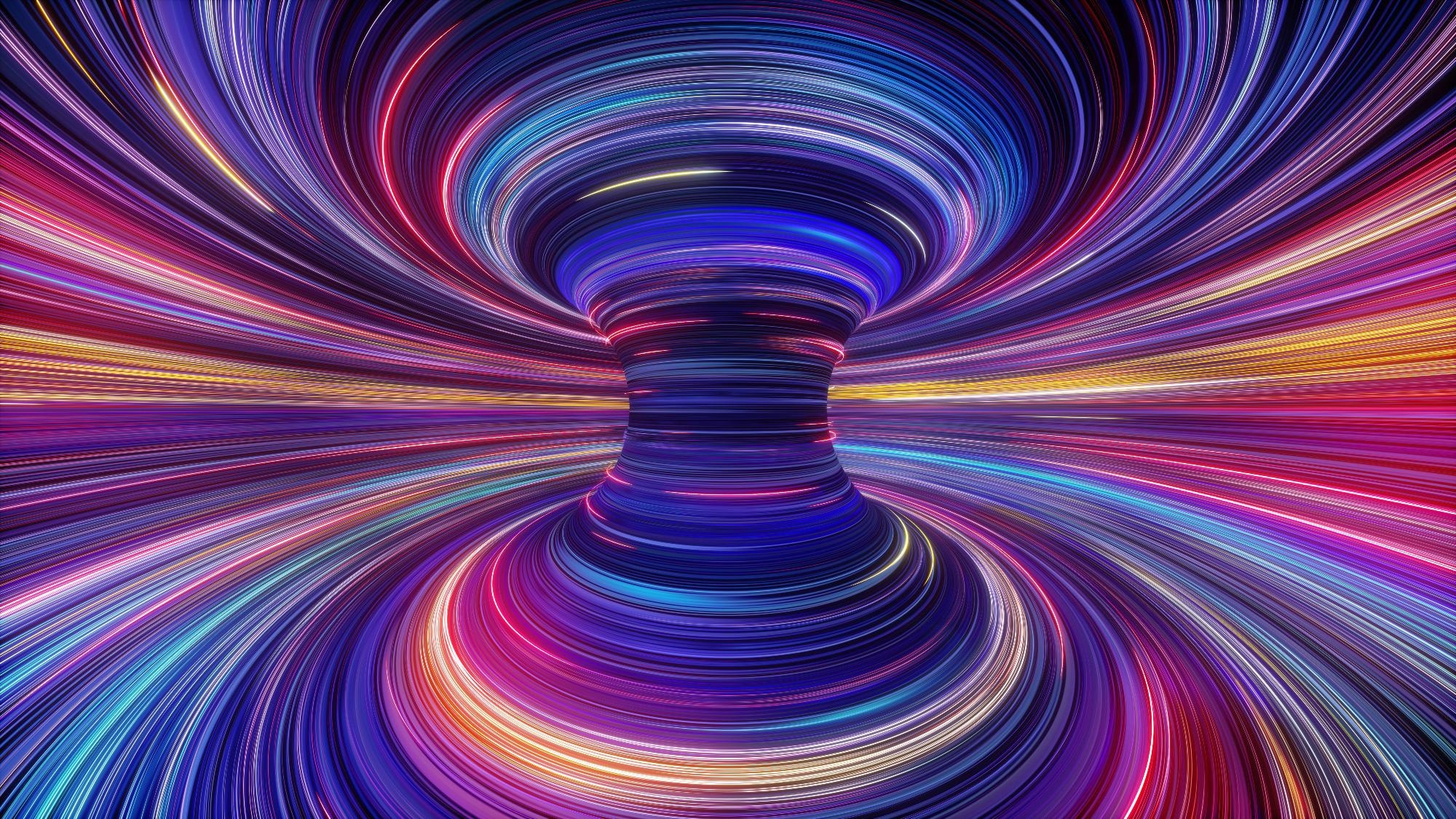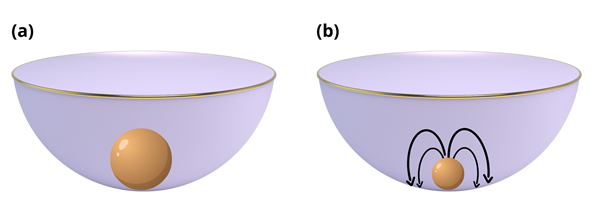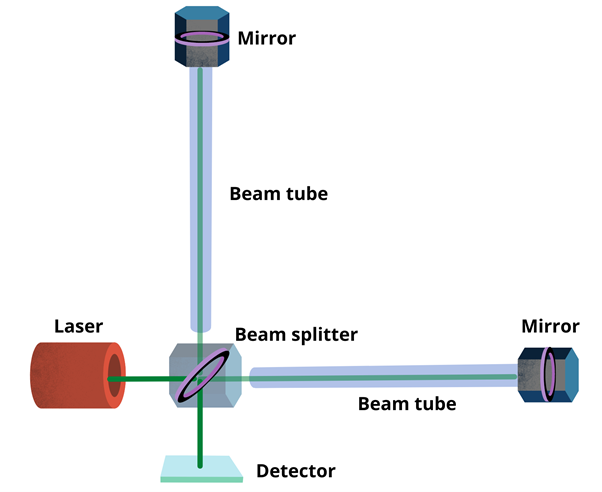Quantum vacuum fluctuations can influence the motion of macroscopic, human-scale objects.

Image Credit: NeoLeo/Shutterstock.com
The impact of quantum fluctuations on large objects was first observed in 2020. Physicists used an experimental setup built to detect gravitational waves to show that quantum fluctuations can impart energy on macroscopic objects. A 40kg mirror was demonstrated to have been “kicked” by quantum fluctuations. The mirror was measured to have moved by a length that is about ten billionths of the size of an atom.
What is Quantum Fluctuation?
A quantum fluctuation is a random temporary change in the total energy at any single point in space. It is an occurrence in nature described by quantum mechanics. Specifically, governed by Heisenberg’s uncertainty principle. Formulated by Werner Heisenberg, in 1927, the uncertainty principle states that for any quantum system, or particle, the exact location in space and the momentum of the particle cannot be known at the same time. The following analogy, illustrated in figure 1, describes how the uncertainty principle applies to quantum fluctuations.

Figure 1: (a) Large scale objects like a marble in a bowl will sit motionless at the bottom of the bowl. (b) Particles governed by quantum mechanics will fluctuate in vacuum as described by Heisenberg’s uncertainty principle. Figure 2: Schematic illustration of LIGO. Image Credit: Ilamaran Sivarajah
A marble set at the bottom of a bowl will remain there motionless indefinitely. If the marble is let go from an edge at the top of the bowl, it’ll roll down the inner surface and settle at the bottom of the bowl. The bottom of the bowl represents the lowest energy level that the marble can occupy.
But if a very lightweight particle is considered in microscopic conditions in a vacuum where quantum mechanics applies, the particle cannot sit motionless at the bottom of the bowl. If it did, the position and the momentum would be known. This would violate the uncertainty principle because if the exact position can be measured then the particle will have some momentum — a continuous jitter preventing the particle from settling down. This jitter and the energy associated with it is quantum fluctuation.
Quantum fluctuations can take the form of particles. For example, particles of light called photons. So, empty space in a vacuum can be thought of as flickering particles analogous to a field of millions of fireflies.
Quantum fluctuation is far too subtle to be detected in everyday objects, like the marble in the bowl. Scientists observed the impact of quantum fluctuations using an experimental setup that was constructed to detect gravitational waves.
Gravitational Waves
Gravitational waves are disturbances in space created by cosmological events such as collapsing stars. Gravitational waves propagate much like ripples on a pond. They are stronger near where the event occurred and get weaker as they travel further from the center. When such gravitational waves reach earth after traveling millions of light-years, the ripples they make are much smaller than the size of an atom.
Gravitational waves were proposed by Henri Poincaré in 1905. Albert Einstein later predicted their existence based on the general theory of relativity. Physicists experimentally observed gravitational waves for the first time in 2015.
The Laser Interferometer Gravitational-Wave Observatory (LIGO)
The most sensitive measuring device in the world was built to measure gravitational waves. The Laser Interferometer Gravitational-Wave Observatory (LIGO) is a large-scale physics experiment constructed with the support of the National Science Foundation. Two identical LIGO detection observatories are situated in Washington state and in Louisiana. LIGO uses laser interferometry to detect very weak shifts in the laser beam.
Each LIGO detector is constructed with two perpendicular beam tubes as depicted in figure 2. Each beam tube extends to 4 kilometers. A powerful laser beam is sent to a beam splitter, which divides the beam into two perpendicular beams. Each beam travels the length of each beam tube and reflects off highly reflective mirrors. The returning beams are combined at the beam splitter and directed into a photodetector.
When a gravitational wave passes through the laser beam it alters the properties of the laser. It stretches and compresses the length the laser travels along the beam tube. This subtle disturbance is picked up by the photo-detector.

Figure 2: Schematic illustration of LIGO. Image Credit: Ilamaran Sivarajah
Since the signal being detected is very weak, various filtering mechanisms are used to suppress external noise that can affect the measurement. Vibrations, heat, electronic and magnetic noise are some of the noise features that can interfere with detection.
Apart from these noise characteristics, lasers also generate a noise described as the standard quantum limit. This is also referred to as the quantum noise limit. Quantum noise arises from the balance between the uncertainties of the number of light particles impacting the detector and the number of photons counted by the detector. To make detection below the quantum noise level, Scientists at LIGO implemented light squeezing.
Squeezed light
Squeezed light is a quantum mechanical property of light with noise below the standard quantum limit. The properties of a light wave can be manipulated such that the quantum noise is reduced. The phase or amplitude component of a light wave can be “squeezed”.
The phase of a wave, or any given point on the cycle of a wave, is usually described as an angle. A wave starts at zero degrees and completes a full cycle, going through the peak and trough in 360 degrees. By experimenting with squeezed light at different phase angles, scientists have optimized the sensitivity of the LIGO detector.
Observation and Implications
Squeezed light does not improve the output signal of the laser interferometer at LIGO. It reduces the noise in the measurements, thereby increasing the sensitivity of LIGO. With Squeezed light, the mirror in LIGO was detected to have been “kicked” a very small amount by quantum fluctuations.
The quantum noise in LIGO’s detectors moved the mirrors by 10-20 meters. That is 10-10 times smaller than the hydrogen atom. Being able to detect signals beyond the quantum limit is expected to improve the observation of gravitational waves further at LIGO. Measurements of quantum fluctuations are also broadly applicable for future quantum noise-limited experiments and devices.
References and Further Reading
Yu, H., McCuller, L., Tse, M. et al. Quantum correlations between light and the kilogram-mass mirrors of LIGO. Nature 583, 43–47 (2020). https://doi.org/10.1038/s41586-020-2420-8
McCuller. L et al, “Frequency-Dependent Squeezing for Advanced LIGO,” Phys. Rev. Lett. 124, 171102 (2020) https://doi.org/10.1103/PhysRevLett.124.171102
Jess McIver & D. H. Shoemaker (2020) Discovering gravitational waves with Advanced LIGO, Contemporary Physics, 61:4, 229-255, DOI: 10.1080/00107514.2021.1946264
Craig, N., Katz, A., Strassler, M. et al. Naturalness in the dark at the LHC. J. High Energ. Phys. 2015, 105 (2015). https://doi.org/10.1007/JHEP07(2015)105
Disclaimer: The views expressed here are those of the author expressed in their private capacity and do not necessarily represent the views of AZoM.com Limited T/A AZoNetwork the owner and operator of this website. This disclaimer forms part of the Terms and conditions of use of this website.